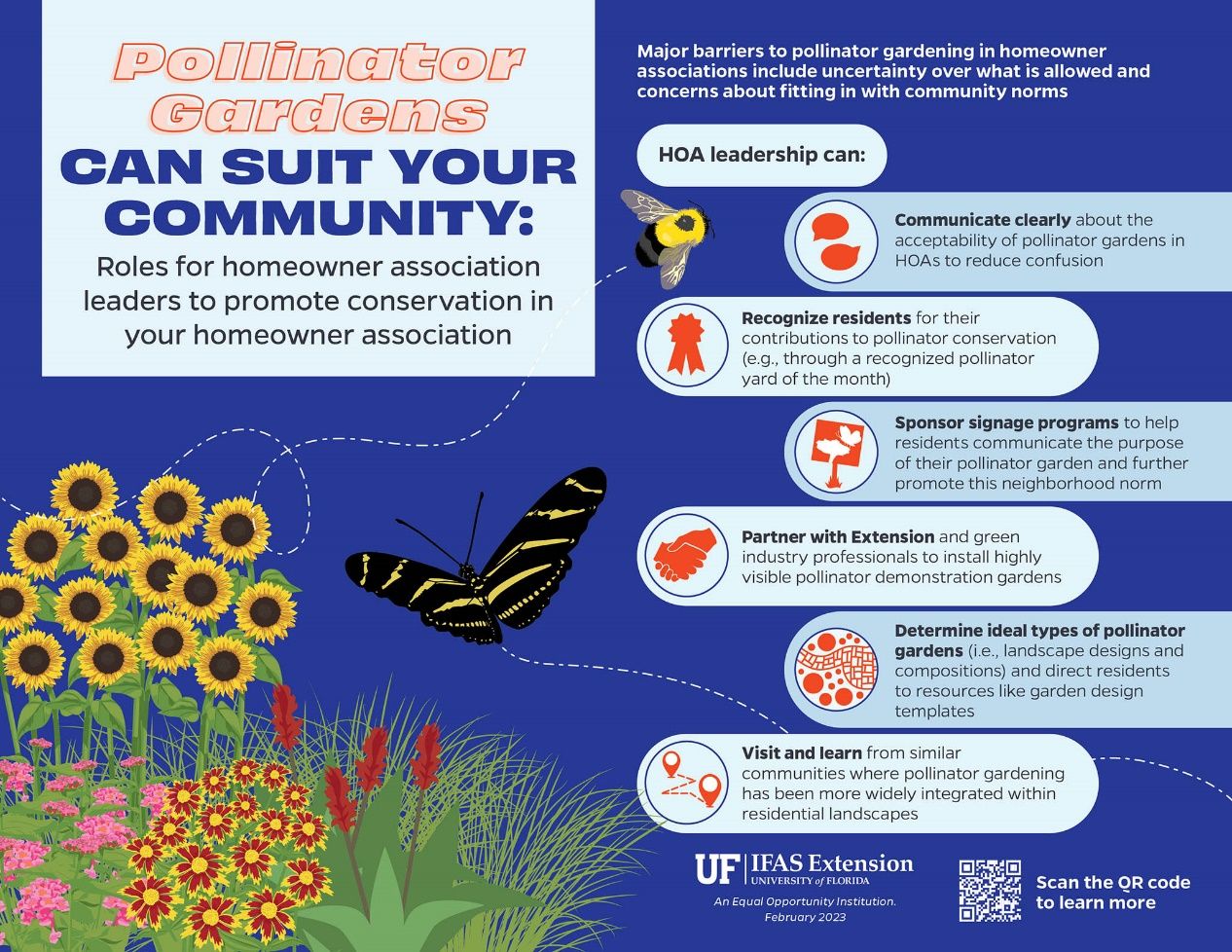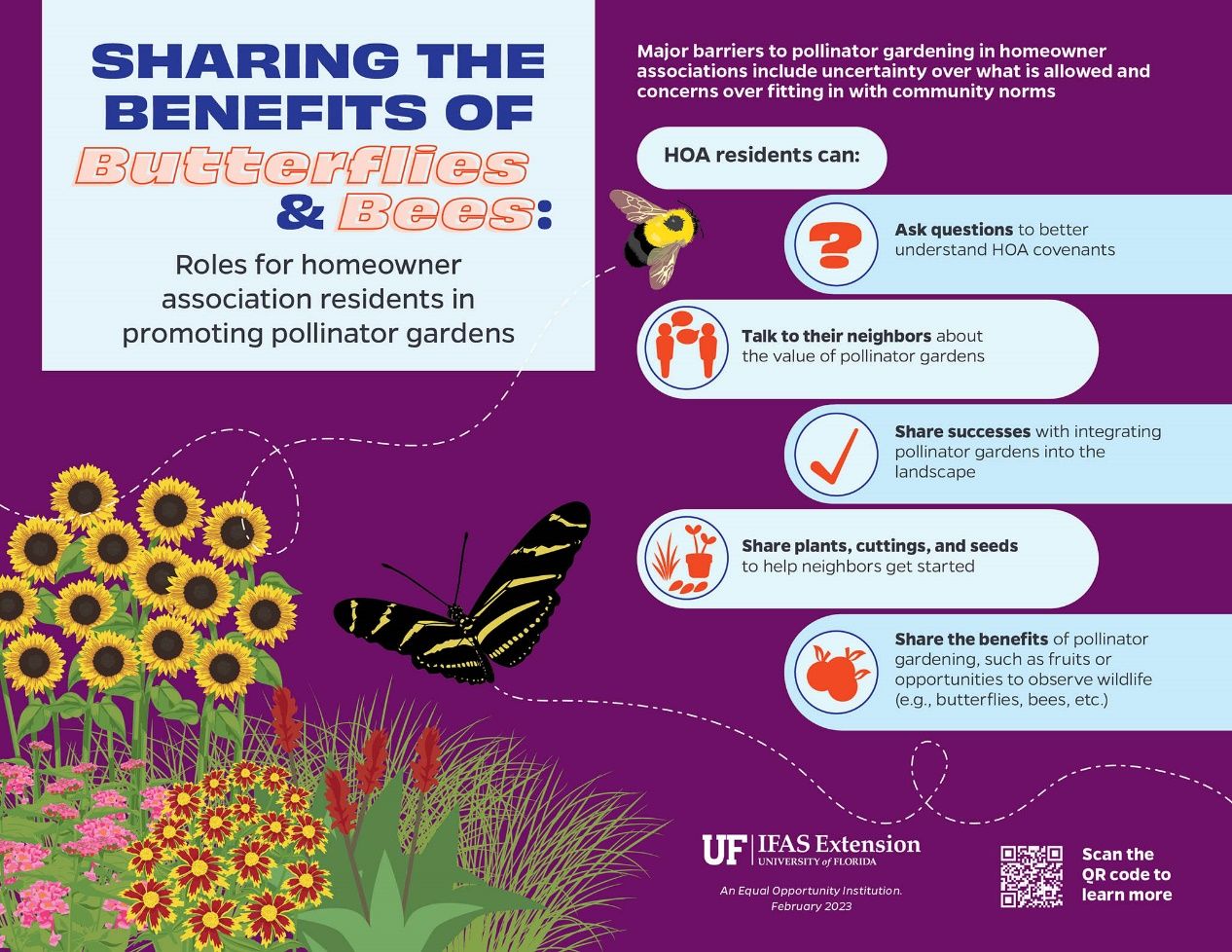Barriers and Opportunities for Pollinator Gardening in Homeowners’ Associations
Introduction
Pollinator gardening is an important component of conservation to combat against the consequences of rapid urbanization, including habitat fragmentation and the blockage of migration corridors (Patel et al., 2021). Residential yards can support pollinators and help to restore their habitats. An opportunity thus exists for Extension and other practitioners to encourage greater engagement in pollinator gardening. However, as with any behavior change, it is important to understand the factors impeding a target audience’s adoption of a practice (Bosone et al., 2022; McKenzie-Mohr & Shultz, 2014). Unique perceived barriers may exist among residents in homeowners’ associations (HOAs); by focusing on knowledge, perceptions, barriers, and needs, Extension professionals and other practitioners can encourage residents and HOA stakeholders to take steps toward the adoption of pollinator gardening (McKenzie-Mohr & Shultz, 2014; Warner, 2019). This publication is for HOA members, community leaders, Extension professionals, and others who work with residents on landscaping and related topics. It presents findings and guidance drawn from two research studies conducted in Florida. Florida is second only to California in terms of number of HOAs and number of residents in HOAs (Foundation for Community Association Research, 2021), and thus, facilitating pollinator gardening in this type of community represents an important opportunity.
Research Approach
As intended, the research described here explored Florida residents’ knowledge, perceptions, barriers, and needs pertaining to pollinator gardening. The findings highlighted in this document focused on residents’ feelings about pollinator gardening and related topics specific to HOAs, which we captured through focus groups and surveys.
In August of 2021, we conducted three online focus groups with a total of 20 adult Florida residents; these individuals were dispersed throughout the state and ranged in their gardening interest and skill levels. The focus group findings were then used to design a survey instrument. Survey data were collected in February and March of 2022 from a total of 1,598 adult Florida residents that were representative of Florida in terms of race/ethnicity, age, and sex/gender. Some focus group participants and survey respondents lived in HOAs, and the data presented below highlights findings specific to HOAs.
Study Context
About 600 survey respondents (40% of the total surveyed) lived in an HOA. Although this information was not collected from focus group respondents, based on the discussions, we estimate that a minimum of approximately one-fourth lived in HOA communities. Of the survey respondents who lived in an HOA:
- 61% indicated their HOA has policies related to their landscaping;
- 68% indicated their HOA penalized residents for the look of their landscape;
- 38% indicated their HOA rewarded residents for the look of their landscape;
- 44% indicated their HOA allows pollinator gardens; and
- 42% were unsure if pollinator gardens are allowed.
Findings
Both the survey and focus group data indicate that HOA residents could be more engaged in pollinator gardening within their HOAs, but a number of barriers—both real and perceived—hinder this practice. Many residents in HOAs could in fact have pollinator gardens that meet community guidelines (see Florida Statute 720.3075; Gusto et al., 2023; Hansen & Lewis, 2018), but participants described experiences with HOAs that discourage their adoption of pollinator gardening. Some described comments from neighbors and others regarding the look of pollinator gardens not fitting a particular norm, indicated by comments they had received or heard such as:
- “Well, that’s not manicured.”
- “Those people . . . never mow their yard. I’m going to call the county on them.”
Some focus group participants described negative consequences of having a pollinator garden, including fines and reprimands:
- [A resident took] “out the grass in his front yard and ended up being told, put the grass in, or you get a fine.”
- [When you have a pollinator garden] “you get your little nasty letter about how your yard looks.”
Beyond barriers, we explored HOA residents’ engagement in pollinator gardening and their intent to engage in pollinator gardening further in the survey. Findings revealed that HOA residents who were unsure whether their community had policies related to their landscaping were the least likely to engage in pollinator gardening; HOA residents who indicated that their community allowed pollinator gardens were more likely to engage in the practice than those who were unsure of their HOA’s pollinator gardening policy or indicated that their community did not allow pollinator gardens.
Despite this, residents were actively seeking out opportunities to overcome perceived barriers. For example, focus group participants talked about strategies for having pollinator gardens within their HOAs. Some suggested keeping pollinator plants more controlled by using, for example, “stuff that is sort of contained and less ridiculous . . . pollinator friendly, but they’re [sic] not crazy.” Others considered engaging in pollinator gardening where they felt that they had more freedom: in their backyards. “I try to keep my front yard more, I don’t know, groomed, I guess,” said one participant. “I think that there is that perception that you want to have a nice-looking front yard.”
Summary of Findings
The findings highlight two primary types of barriers to pollinator gardening in HOAs. First, despite strong interest in having a pollinator garden, there is a large proportion of HOA residents who are unsure whether they are allowed to have a pollinator garden; these individuals are less likely to engage in pollinator gardening. Second, there is a smaller yet important proportion of HOA residents who believe that they cannot engage in pollinator gardening. The reality is that many residents in HOAs could have pollinator gardens that meet community guidelines. However, many residents reported facing (or having concerns about) a related, overarching barrier of judgement from neighbors regarding a nontraditional landscape aesthetic, regardless of whether such landscapes are technically allowed in the HOA. Given that over nine million residents live in HOAs in Florida (Foundation for Community Association Research, 2021), there is an incredible opportunity to correct misperceptions and shift norms among this group.
How Extension and Other Practitioners Can Apply this Information
To address the barriers described above, Extension and other practitioners can encourage pollinator gardening in HOAs by working with these communities and other community partners. Programs might be held within these communities while education and communications may also be marketed directly to them. Specifically, there are opportunities to:
- Seek out partnerships with HOA leaders based on mutual interests in landscape and wildlife conservation. Identifying existing social groups and behaviors in these communities—such as those focusing on wildlife, gardening, and conservation—can be a source of interest to build on when promoting increased engagement in pollinator gardening.
- Educate residents who are unsure whether or believe that policies prevent them from pollinator gardening. In most cases, HOA restrictions do not prevent pollinator gardening, but there may be requirements regarding how to change one’s landscape. Even if a certain aesthetic (e.g., level of formality) is mandated, there are pollinator planting options to fit with different aesthetics.
- Interpret for or educate residents about HOA landscape requirements beyond the horticultural specifics of pollinator gardening. For example, community classes on pollinator gardening typically teach on locally appropriate or environmentally friendly plant species, etc.; these lessons should be paired with discussions on how this type of gardening can meet typical HOA requirements.
- Offer expertise (horticultural knowledge, group facilitation, policy development) to help HOA leaders revise their residential landscape policies to be more inclusive of pollinator gardening.
- Help HOA leaders understand the misperceptions that exist so that they may better communicate their approval of pollinator gardens and its benefits. HOA leaders can, for example, explain how residents can maintain a “groomed” yet natural yard to meet community requirements while still supporting pollinators critical for biodiversity and key ecosystem services (Patel et al., 2021).
- Develop strategies to change residential norms and increase buy-in surrounding pollinator gardening. In many cases, a norm can be underperceived (less visible), meaning people may not be aware of the extent others are engaging in a practice, especially when a norm for a competing behavior (e.g., a turfgrass-dominated landscape) is strong.
By highlighting (or increasing) the presence of pollinator gardens in the HOA, Extension and other practitioners can help residents see that these types of gardens do exist. Pollinator gardens in common areas could demonstrate that these types of plantings are appreciated and welcome in the community, including in residents’ yards. Pollinator garden tours in HOA neighborhoods can facilitate education by increasing the visibility of backyard gardens (which are often not seen). Signage recognizing the presence of a pollinator garden could also make pollinator gardening more visible. Signage can share information about the plants and describe the pollinators that they support. Extension professionals should consider posting maps or photographs of pollinator gardens on the newsletters and pollinator-gardening literature that they distribute or in public spaces throughout neighborhoods.
HOA Leadership and Residents Can Apply this Information
Some of the opportunities for Extension and other practitioners to support pollinator gardening in HOA communities are distinct from those of HOA leadership and residents. The infographics in appendices A and B contain concise, specific recommendations for each of these groups. For more, visit the helpful resources below.
Recommended Resources for Integrating Pollinator Gardens into HOAs
- “Attractive Native Bees to Your Florida Landscape”
- Florida-Friendly LandscapingTM FFL Gardens app (with bee garden design and plant lookup features)
- Florida-Friendly LandscapingTM FFL Gardens app (with butterfly garden design and plant lookup features)
- Florida-Friendly LandscapingTM Program’s “Make Your Community Florida-Friendly” page has many resources including:
- “Ten Strategies for Working with Your Home Owner Association to Convert to a Florida-Friendly Yard”
Conclusion
Research suggests that HOA residents face both real and perceived barriers to engaging in pollinator gardening. Importantly, many HOA dwellers are unsure whether they are permitted to engage in pollinator gardening, and they may perceive that this approach to landscaping is incompatible with neighborhood norms. These barriers must be addressed at the resident and HOA leadership levels to help more people engage in gardening to support pollinators.
Acknowledgements
This work was supported by USDA National Institute of Food and Agriculture’s (NIFA’s) Fiscal Year 2020, Program A1113, Pollinator Health: Research and Application under accession number 1024852.
References
Bosone, L., Chaurand, N., & Chevrier, M. (2022). To change or not to change? Perceived psychological barriers to individuals’ behavioural changes in favour of biodiversity conservation. Ecosystems and People, 18(1), 315–328. https://doi.org/10.1080/26395916.2022.2071343
Foundation for Community Association Research. (2021). 2020–2021 U.S. national and state statistical review. https://foundation.caionline.org/wp-content/uploads/2021/07/2021StatsReview_Web.pdf
Gusto, C., Silvert, C., Warner, L., Diaz, J., & Mallinger, R. (2023). Exploring Floridians’ perceptions of pollinator-friendly gardening to identify critical adoption barriers and strategies. Urban Forestry & Urban Greening, 81, 127867. https://doi.org/10.1016/j.ufug.2023.127867
Hansen, G., & Lewis, C. (2018). Ten strategies for working with your home owner association to convert to a Florida-friendly yard. AskIFAS, ENH1252. http://edis.ifas.ufl.edu/EP513
McKenzie-Mohr, D., & Schultz, P. W. (2014). Choosing Effective Behavior Change Tools. Social Marketing Quarterly, 20(1), 35–46. https://doi.org/10.1177/1524500413519257
Patel, V., Pauli, N., Biggs, E., Barbour, L., & Boruff, B. (2021). Why bees are critical for achieving sustainable development. Ambio, 50(1), 49–59. https://doi.org/10.1007/s13280-020-01333-9
Prohibited clauses in association documents, Florida Statute 720.3075. (2020). https://www.flsenate.gov/laws/statutes/2020/720.3075
Warner, L. A. (2019). Using homeowners’ association membership to define audience segments for targeted local social marketing interventions: Implications from a statewide study. Social Marketing Quarterly, 25(4), 291–307. https://doi.org/10.1177/1524500419882978
Appendix A: For HOA Leadership

Credit: UF/IFAS Communications
Appendix B: For HOA Residents

Credit: UF/IFAS Communications



